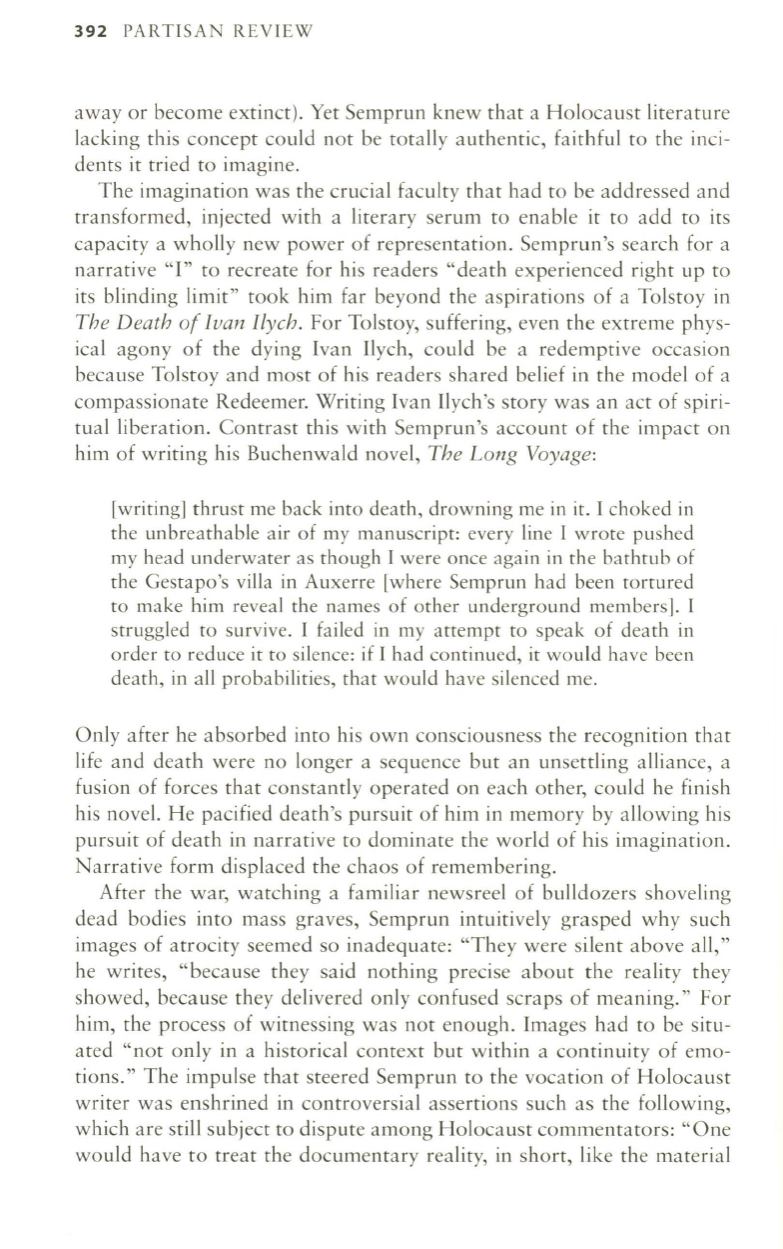
392
PARTISAN REVIEW
away or become extinct}. Yet Semprun knew that a Holocaust literature
lacking this concept could not be totally authentic, faithful to the inci–
dents it tried to imagine.
The imagination was the crucial faculty that had to be addressed and
transformed, injected with a literary serum to enable it to add to its
capacity a wholly new power of representation. Semprun's search for a
narrative "I" to recreate for his readers "death experienced right up to
its blinding limit" took him far beyond the aspirations of a Tolstoy in
The Death of Jvan llych.
For Tolstoy, suffering, even the extreme phys–
ical agony of the dying Ivan I1ych, could be a redemptive occasion
because Tolstoy and most of his readers shared belief in the model of a
compassionate Redeemer. Writing Ivan Ilych's story was an act of spiri–
tual liberation. Contrast this with Semprun's account of the impact on
him of writing his Buchenwald novel,
The Long Voyage:
[writing] thrust me back into death, drowning me in it. I choked in
the unbreathable air of my manuscript: every line I wrote pushed
my head underwater as though I were once again in the bathtub of
the Gestapo's villa in Auxerre
r
where Semprun had been tortured
to make him reveal the names of other underground membersJ. I
struggled to survive. I failed in my attempt to speak of death in
order to reduce it to silence: if I had continued, it would have been
death, in all probabilities, that would have silenced me.
Only after he absorbed into his own consciousness the recognition that
life and death were no longer a sequence but an unsettling alliance, a
fusion of forces that constantly operated on each other, could he finish
his novel. He pacified death's pursuit of him in memory by allowing his
pursuit of death in narrative to dominate the world of his imagination.
Narrative form displaced the chaos of remembering.
After the war, watching a familiar newsreel of bulldozers shoveling
dead bodies into mass graves, Semprun intuitively grasped why such
images of atrocity seemed so inadequate: "They were silent above all,"
he writes, "because they said nothing precise about the reality they
showed, because they delivered only confused scraps of meaning." For
him, the process of witnessing was not enough. Images had to be situ–
ated "not only in a historical context but within a continuity of emo–
tions." The impulse that steered Semprun to the vocation of Holocaust
writer was enshrined in controversial assertions such as the following,
which are still subject to dispute among Holocaust commentators: "One
would have to treat the documentary reality, in short, like the material


